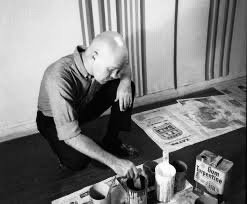Gene Davis (1920 - 1985)
GENE DAVIS
Gene Bernard Davis was born in Washington, DC.
“The feeling we experience in Davis’ work signifies our discovery that our perception has been force into a certain direction. Realizing that Davis has directed our perception with an iron grip, we become aware of the directednees of perception as such; the feeling is of this directednees being revealed to ourselves - the “sensation” of our consciousness taking a certain direction, acquiring a certain form. Davis’ work generates a primordial subjective experience of perception as directednees. The subjectivity increases when we realize that the color constellations seem to be directing us to what Maurice Merleau-Ponty calls the “pre-objective ream,” the realm of the indeterminate, from which the direction originates and from which we get our sense of the direction our perception should take. This is why Davis’ brilliantly determinate paintings have such a profound subjective effect: they signal the objective, and which, as a residue of superficially irregular but in fact carefully determined color pattern, they have left behind.”
Gene Davis, Charles Cowles Gallery
Artforum 1985 by Donald Kuspit
Artist: Gene Davis
Title: Untitled 1982
Medium: Acrylic on canvas
Size: Height: 65.75 inches / 167 cm
Width: 90.94 inches / 231 cm
Provenance: Estate of the artist / Smithsonian American Art Museum
Private Collection
“The time element in my work has been missed by most critics. That is, the analogy between dividing up two-dimensional space and dividing up time. It's almost as if I were, in my stripe paintings, doing an abstraction of time -a spatial abstraction of time."
In a 1975 interview with the Architect Donald Wall



